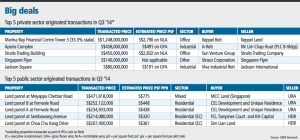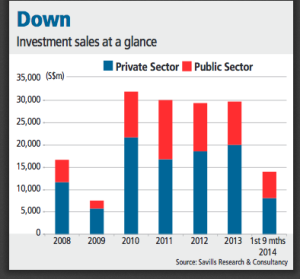M+S Pte Ltd, the developer behind the mega mixed-use project Marina One, is taking a calibrated tack with its upcoming launch of the residential units in the development, and is dangling early-bird discounts of 10 per cent on selected units.
On the expected launch date of Oct 11, it will release only 150 to 200 units in the first block, instead of all 521 at a go.
It will also hold back the release of the 521 units in the second residential block until after the project’s temporary occupation permit (TOP) is issued, said Kemmy Tan, the chief operating officer of M+S.
Prices at Marina One Residences will range from S$1,960 to S$3,100 per square foot (psf), which is on par with transacted prices in the area, she added.
Market watchers believe that holding back half the residential units until TOP is a move to avoid flooding the market with too many units upon the project’s completion in 2017, which could weigh on the rental market in that area.
Nicholas Mak, the executive director at SLP International, said: “This is to reassure buyers that they are not going to flood the market, but it does not change the fact that there are 1,042 units in the project.”
But Ms Tan explained that the rationale for holding back the second residential block was to allow the developer to “ride on the future growth of Singapore”.
M+S is not required to finish selling the units within a stipulated time because it does not come under qualifying certificate (QC) rules, under which a developer has to finish building a residential project in five years and sell the units within two years of its completion.
M+S, a joint venture between Temasek Holdings and Malaysian sovereign wealth fund Khazanah Nasional, was set up after a historic land swop between the two countries.
Its other project in Singapore, the 660-unit Duo Residences in the Ophir-Rochor area, is already 94 per cent sold.
Ms Tan said she expects the profile of buyers for Marina One Residences to be similar to that of Duo Residences, where 70 per cent of buyers are Singaporeans and 14 per cent, Malaysians; some of these buyers were bulk purchasers.
While the window for expression of interest will close only this Sunday, the first 150 to 200 units to be released are already over-subscribed, she said.
The pricing list from agents indicates that a one-bedroom unit of 700 sq ft starts at S$1.4 million; a two-bedder of 1,001 sq ft starts at S$2 million, and a three-bedder of 1,539 sq ft, at S$3.46 million.
Some consultants note that such price levels could still prove challenging, given similar price quantums for some freehold units in prime districts. In addition, there are more developments coming up in the Marina Bay area.
Ms Tan said, however, that Marina One is expected to draw empty nesters looking for city apartments, investors looking to rent to expatriates and seasoned buyers scouting for “trophy assets” here.
Potential buyers can be looking at a rental yield of 2 to 3 per cent in the area and capital appreciation, given URA’s masterplan for Marina South, she said.
One major draw of the project is “the Green Heart” – a biodiversity garden of lush greenery covering 65,000 sq ft and featuring a 13.2 m high waterfall, she added.
The project is also seamlessly connected to four MRT lines via three stations – the Marina Bay station, Downtown station and the future Shenton Way station.
Ms Tan said: “We are ready (to launch) and there is demand, especially since Duo is substantially sold at 94 per cent. I have buyers who come to me to ask when we are going to launch this.”








